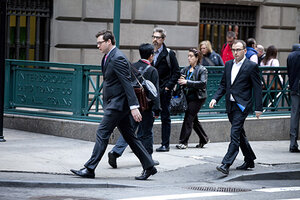Saving money in a big city? It's possible.
Living in an urban area like New York or San Francisco can ratchet up your expenses. Hamm offers five ways to manage your money while enjoying big-city life.

Commuters emerge from the subway and walk to work down Wall Street near the NYSE in New York, New York. Using public transportation to get to work can save you from shelling out money on car insurance, vehicle registration, gas, and loans.
Melanie Stetson Freeman/The Christian Science Monitor/File
I make no bones about the fact that I live in a rather rural area. I live on the very edge of a small town. The nearest grocery store is about ten miles away. This is a low cost-of-living area, in other words. It’s not the lowest in the country by any stretch of the imagination, but when I hear stories about New York and San Francisco, I almost choke.
Many of the things I talk about in terms of saving money tend to apply best in the area I live in, which is natural since the writing here is a reflection of my own experiences.
What about living frugally in one of those high-cost areas?
I have several friends and family members who live in large cities across the United States and I’ve exchanged money saving tips with many of them. Some of those tactics work really well in the areas where they live… but they don’t really work around here.
Here are some of the best ones, the tactics my city friends swear by.
Hit yard sales in any and all neighborhoods more expensive than your own. People are often selling things at rock bottom prices that you would be quite happy to own. If you’re willing to carry it a bit further, you can do the same thing on trash day and do some “curbside recycling” in those more expensive areas.
Pay attention to grocery store competition. Around here, there are only a few grocery store chains and they scarcely compete with each other. A friend of mine who lives near Chicago claims that there are at least ten different grocery store chains within a few miles of her home and that the competition can be fierce.
As I’ve mentioned before, I typically shop using a grocery store flyer, but once you get away from the flyer sales, you have to rely more on the regular prices in the store. With my friend, having so many chains means that she can pretty much do all of her grocery store shopping using the flyer items from several different stores. She’ll make a loop out of them on grocery day, buying pretty much nothing but items from the flyer at each store.
Enjoy the tons of free cultural entertainment. A large city has lots of museums, art exhibits, parks, public speeches, demonstrations, political rallies, concerts, and countless other things going on for free pretty much every single day. Pay attention to what’s going on in the city and the surrounding suburbs and you’ll find a lot of things to do for free.
For comparison’s sake, while there are a surprising amount of free activities around here, it doesn’t compare to the breadth and depth of options that my friends in, say, Seattle have available to them.
Use public transportation! If you have access to a strong public transportation system, use it. Most cities have an amazing public transportation system that can get you wherever you need to go. This can mean fewer cars in your household, which means lower insurance costs, lower vehicle registration costs, lower fuel costs, and no car loan, either.
Use carpooling. Most metro areas do a lot of things to encourage carpooling, including having high occupancy vehicle (HOV) lanes on the major roads leading into the city. If you have anyone in your neighborhood who works where you do, start commuting with them. It will save you both half of your miles on your car plus the commute will go faster.
I live in an area where all of these tactics are difficult at best and impossible at worst. If I had these opportunities here, you bet I’d be on board with them.


